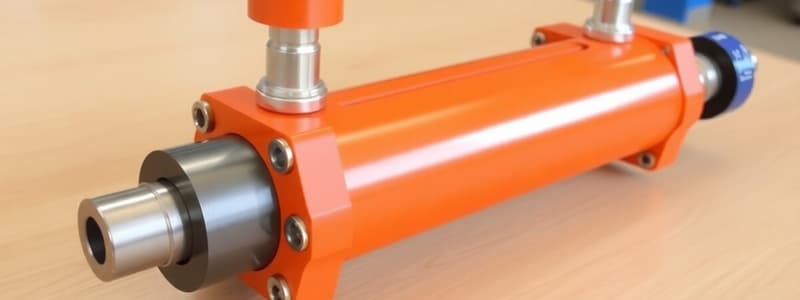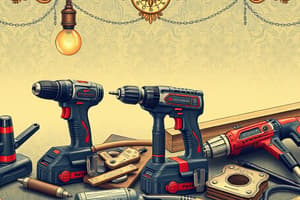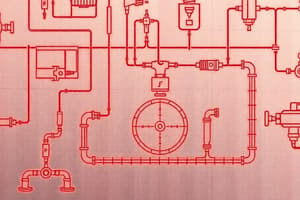Podcast
Questions and Answers
What is the function of pneumatic system devices?
What is the function of pneumatic system devices?
To convert compressed air energy into mechanical energy
What is a Single Acting Cylinder used for?
What is a Single Acting Cylinder used for?
For tasks that do not require a significant amount of force
What are the typical size limits for commonly produced single-acting cylinders?
What are the typical size limits for commonly produced single-acting cylinders?
Up to 100 mm in diameter and a stroke of up to 100 mm
Which of the following is a component of a single-acting cylinder?
Which of the following is a component of a single-acting cylinder?
What is the function of a double acting cylinder?
What is the function of a double acting cylinder?
What is the primary characteristic of a double-acting cylinder without cushioning?
What is the primary characteristic of a double-acting cylinder without cushioning?
What is the purpose of using air as a cushion in double-acting cylinders?
What is the purpose of using air as a cushion in double-acting cylinders?
Describe a double end rod cylinder.
Describe a double end rod cylinder.
What is the range of motion for the piston rod in a rotary actuator?
What is the range of motion for the piston rod in a rotary actuator?
What is an air motor typically used for?
What is an air motor typically used for?
How do grippers function?
How do grippers function?
What are vacuum generators used for?
What are vacuum generators used for?
Flashcards
Pneumatic Actuators
Pneumatic Actuators
Devices that operate using compressed air to convert pneumatic energy into mechanical work.
Single Acting Cylinder
Single Acting Cylinder
A cylinder where the air pressure acts in only one direction, and a spring returns it to its original position.
Double Acting Cylinder
Double Acting Cylinder
A Cylinder where air pressure can be applied in both directions to extend and retract the piston rod.
Cylinder Without Cushioning
Cylinder Without Cushioning
Signup and view all the flashcards
Cylinder with Air Cushion
Cylinder with Air Cushion
Signup and view all the flashcards
Double End Rod Cylinder
Double End Rod Cylinder
Signup and view all the flashcards
Rotary Actuator
Rotary Actuator
Signup and view all the flashcards
Air Motor
Air Motor
Signup and view all the flashcards
Grippers
Grippers
Signup and view all the flashcards
Grippers - Finger Separating
Grippers - Finger Separating
Signup and view all the flashcards
Parallel Grippers
Parallel Grippers
Signup and view all the flashcards
Vacuum Generators
Vacuum Generators
Signup and view all the flashcards
Piston
Piston
Signup and view all the flashcards
Piston Rod
Piston Rod
Signup and view all the flashcards
Return Spring
Return Spring
Signup and view all the flashcards
Base End Cover
Base End Cover
Signup and view all the flashcards
Head End Cover
Head End Cover
Signup and view all the flashcards
Cylinder Tube
Cylinder Tube
Signup and view all the flashcards
Pressure Connection
Pressure Connection
Signup and view all the flashcards
Vent Hole
Vent Hole
Signup and view all the flashcards
Study Notes
- Pneumatic system devices function to convert compressed air energy into mechanical work.
Single Acting Cylinder
- Single acting cylinders are suitable for applications requiring less force.
- The acting force is countered by a spring.
- Commonly produced with a bore size of no more than 100 mm and a stroke of no more than 100 mm.
Single Acting Cylinder Components
- Piston
- Piston rod
- Return spring
- Base end cover
- Head end cover
- Cylinder tube
- Pressure connection
- Vent hole
- Bash and sealing element
- Piston seal
Double Acting Cylinder
- Double acting cylinders.
Double Acting Cylinder Components
- Seal and piston
- Cylinder tube
- Air seal
- Piston rod
Double Acting Cylinder (No Cushioning)
- Double acting cylinders without cushioning use air pressure for movement in both directions.
- Affordable option suitable for low-speed applications.
Double Acting Cylinder (Cushioning)
- Double acting cylinders with cushioning are designed for higher speed operations.
- Movement relies on air pressure.
- Air cushioning is used to prevent impact between the piston and end caps at the end of the stroke.
Double End Rod Cylinder
- Double end rod cylinders share a similar structure to single acting cylinders but feature two piston rods.
- Both rods extend from either side and move in alternating directions.
Rotary Actuators
- Rotary actuators feature rods that rotate back and forth but are limited to a maximum rotation of 360°.
- Rotation can be controlled clockwise or counterclockwise.
- Applications require specification of the actuator's rotation angle
Air Motor
- Air motors are used in high-impact applications or those needing air pressure to impact a workpiece beyond normal tasks, such as drilling.
- Can rotate 360 degrees.
Grippers
- Grippers employ mechanical mechanisms to work in conjunction with cylinders to grip materials or workpieces of various shapes.
- Includes finger separation.
Grippers (Parallel End Type)
- Grippers with parallel fingers.
Vacuum Generators
- Vacuum generators are used for vacuuming and gripping objects.
- Operation is dependent on the design of the rubber cup.
Pneumatic Symbols
- Several Pneumatic symbols that represent
- Single acting cylinder with air pressure
- Spring return
- Double ended piston, double acting cylinder
- Single cylinder with spring return etc
- Motor symbols represented include
- Single driven with adjustable pressure
- Double drive motor with adjustable pressure
- Rotate Cylinder
- The document features symbols for work pieces as well
- Two way operated
- Single way operated
- Parallel movement
- NC/NO push types
Studying That Suits You
Use AI to generate personalized quizzes and flashcards to suit your learning preferences.




